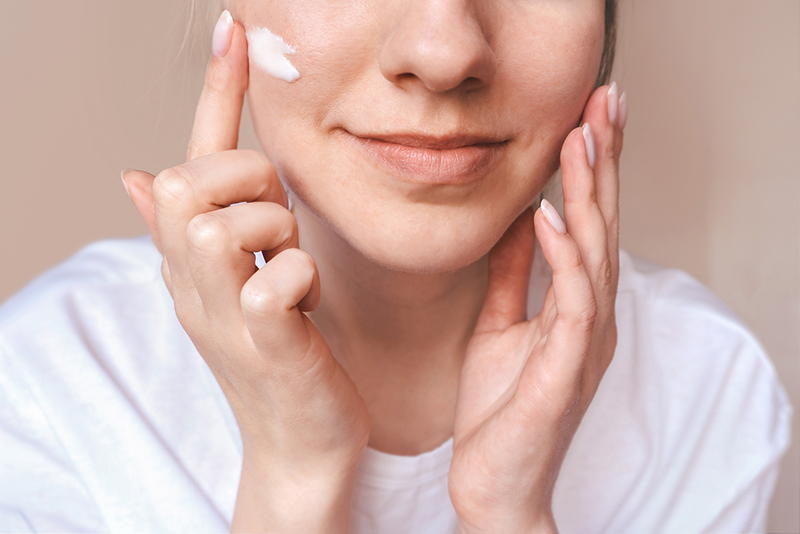Topical treatments for melasma are used to improve the appearance of flare ups. These treatments typically work by altering the pigmentation of the treatment area. They may help affect the process of pigmentation change or help to even the skin tone by increasing skin cell turnover. A compounding pharmacy can combine different ingredients into one cream, mask, or face pad to effectively treat melasma.
Photoprotection
Before proceeding to a topical treatment, it is essential to maintain a rigorous photoprotection regimen. UV exposure is the primary cause of new melasma flare ups and exacerbation of melasma. A broad spectrum sunscreen should be used that protects against UVA and UVB radiation. Sun protecting clothes like wide-brimmed hats can help further reduce sun exposure. In addition, avoiding the sun when it is at its strongest (which can vary depending on where you live) helps reduce the potential for a reaction.
Some women will use makeup to conceal a flare-up of melasma. However it is important to apply a topical medication in the right order to make sure it is effective. The first layer should be the medicated topical, followed by sunscreen after the medication has dried, and finally makeup. Even though some makeup products may include a sun protecting ingredient, often it is not broad spectrum or effective enough to protect against UV radiation-induced flare ups of melasma.
Sunscreen with zinc oxide, titanium dioxide, or iron oxide is generally recommended for individuals with melasma to prevent further flare ups. Dermatologists recommend a physical, mineral sunscreen as opposed to a chemical one. The physical sunscreens block the sun’s rays by reflecting them back vs. absorbing them. Melasma can be triggered not only by the UV radiation but by the heat generated by the sun’s rays. Keeping this heat away from the skin helps reduce the incidence of flare-ups.
Ingredients in Melasma Creams
Melasma creams can include hydroquinone, tretinoin, hydrocortisone, kojic acid, azelaic acid, vitamin C, and more.
Hydroquinone: This ingredient inhibits tyrosinase. Inhibiting tyrosinase prevents the creation of melanin, thus inhibiting the formation of melasma. HQ is a well researched treatment for melasma that is effective for many patients.
Tretinoin: Retinoids like tretinoin can promote the turnover of skin cells. This reduces the prevalence of the melasma skin cells and allows for new, unaffected skin cells to replace them.
Hydrocortisone: Corticosteroids like hydrocortisone can both prevent pigmentation changes and also decrease inflammation. This is especially important when using some of the other ingredients listed here, as many lead to increased inflammation.
Kojic Acid: This ingredient, derived from certain species of fungi, is a tyrosinase inhibitor like hydroquinone. It inhibits melanin production to provide a more even skin tone.
Azelaic Acid: Another tyrosinase inhibitor, azelaic acid has similarly been used to treat melasma by decreasing melanin production. Azelaic acid 20% has been shown to be as effective as hydroquinone 4% at reducing melasma but with fewer side effects than hydroquinone.
Tranexamic Acid: A hemostatic agent often used in dentistry, tranexamic acid can be used orally or topically to manage melasma.
Vitamin C: Ascorbic acid (Vitamin C) has been shown to decrease reactive oxygen species to decrease inflammation.
Niacinamide: An inhibitor of melanocyte transfer, niacinamide is another naturally occurring ingredient that can treat a variety of skin conditions.
It has been demonstrated that the topical application of a melasma treatment can be enhanced with the use of microneedling. The small needles create punctures that allow the medication to better penetrate the epidermis. Other treatments for melasma include chemical peels, microneedling, and laser treatments. These can be used in combination with topical treatments prescribed by a dermatologist.
OTC vs. Prescription
The topical treatments listed above are often available in both over-the-counter and prescription forms. Hydroquinone is no longer available over-the-counter and can only be purchased with a prescription. However some ingredients like kojic acid are available in lower strengths. One combination treatment, Tri-Luma is available in a manufactured form. Most combinations need to be made by a compounding pharmacy with a prescription.
The key differences between the OTC and prescription-only form of these medications are the strength of the ingredients and their combinations. Usually for chronic, moderate to severe cases of melasma a prescription-strength medication combined with dermatological treatments is required.
Compounded Formulations
Our pharmacy compounds a melasma kit that includes four products for treating melasma. The kit includes the following compounded products:
Melasma Mask: Azelaic Acid 15%, Hydroquinone 8%, Kojic Acid 4%, Tretinoin 0.1%
Melasma Maintenance Cream: Hydroquinone 6%, Kojic Acid 4%, Tretinoin 0.05%, Hydrocortisone 0.5%
Face Pads: Salicylic Acid, Sulfacetamide Sodium, Clindamycin
Hyaluronic Acid Cream: Hyaluronic acid and DMAE for face and neck
Using these products
Articles
- Microneedling as an adjuvant to topical therapies for melasma: A systematic review and meta-analysis – Journal of the American Academy of Dermatology
- Melasma: an Up-to-Date Comprehensive Review – Dermatological Therapeutics

